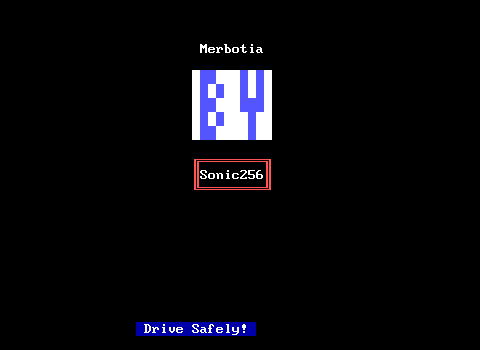Now here's a fun one.
This world caught my eye thanks to the author that made it, a ZZTer by the name of FunkMeister, or more commonly just Funk. Funk was a regular of the community in the 2000s more commonly appearing on z2's forums and ZZTer-ran IRC channels. It occurred to me when I came across this world, that I've never played anything by him, neither back then or since the Museum was started. As it turns out, there's good reason I hadn't played his backlog, as Indiana Jones and the Lost Crusaders is his only solo-credited release., with his most notable work being the graphical overhaul he gave to John W. Wells for the first file of Evil Sorcerers' Party. In terms of pure Funk, (no not that Pure Funk,) this may be the only such example out there.
Given the era in which I was around Funk in the early 2000s, I recall him being a big smelly jerk who was mean to 12 year old me because he thought I was annoying. Before this starts coming off as a hit piece on the man, let's be very clear: he was absolutely right. I was annoying. I have old IRC logs to confirm this. He was a typical teenager and I was a typical pre-teen, and it's not unsurprising that we weren't best friends. But I have to admit, a little bit a devious smile when I realized this game was my opportunity to see what Funk was like at a similar age when he no doubt would have equally annoyed his then-future self.
For those who weren't on IRC back then, you may also remember the name Funk as that guy who left some scathing reviews of your ZZT creations on z2. If you take a look at anything he rated back then, you'll find a few things. First, they are always negative. Nothing gets rated more than 1.0/5.0 except for a single five given to a game made to make fun of another game that he gave a 0.5 to. Second, they are extremely reviews of their time which is why I didn't drop a link to any! Lots of words and phrases that don't do particularly well today, so if you are curious, please brace yourself.
But the most interesting thing to me, is that he did in a few of these less "community drama" reviews, bring up some complaints about well-received games that feel entirely justified today. Funk loathes lengthy yet meaningless story. He can't stand games that take ages to get the gameplay started. He recognizes that a lot of ZZT comedies amount to little more than low-effort parody where something is renamed to rhyme with the source material. Over the years, I've ran across a few of Funk's reviews when writing articles and more often than not, I find myself agreeing with his actual criticisms, just not the crass remarks they're surrounded by. This has happened enough times that when I see a Funk review, I get excited to see somebody doing more than simply mashing the 5.0 button because <recognizable author> has just released <latest title>. Now if only he was able to present those criticisms in a way that wasn't so hostile that no author would bother to try and take heed from anything contained within, they might even be reviews worth sharing now.
So I decided to take a look at Lost Crusaders to see what Funk could actually do himself at a young age. Would his own game be equally deserving of the scorn he dished out? Given that it's from 1996, almost certainly. I'm not sure how old Funk was when he was making this, but I would wager no more than twelve. It was less an interest in seeing the man brought down a notch (these are all the behavior of somebody more than twenty years ago now who has likely long long since grown up), and more of that curiosity as to what it would end up being like. Would it be a good game to solidify his credibility in these old reviews? Would it be a bad game that would serve as evidence that everybody starts somewhere and perhaps you should lighten up a little? Would it be so terrible that those who received low ratings from Funk would have wished they had played and had the chance to give low scores themselves? I just had to find out.
At this point however I've covered enough ZZT worlds by children that you should know that I'm not here to point and mock any weird design decision, baffling sentence, or unintuitive requirements to see the game to the end. It's more fun to celebrate these kind of games than to tear down the art of a child trying something new, and slowly learning what they could do with ZZT. Even if I wanted to, as far as first games go, Funk does an admirable job. There's significantly more to praise here than scoff at. Spoilers: Any lingering thought of how Funk might have reacted if the game was brought up to him in 2002 or whenever were quickly discarded as I got lost in a very cute little adventure game that never in a million years would I have guessed was made by the Funk I remembered.

The Lost Crusade

The introduction to the game is delivered in a usual form of a text window on an unusual board to do so: the title screen. Funk wants players to just hurry up and get on with things, and the reason for Indy being trapped underground isn't important. What is important is how he's going to get back to the surface, and how he's going to protect the people living down there.
Indy, while visiting an island somewhere off the coast of France, bumped into a distraught woman. She claimed that something was "crawling around" in the disused mine up north, and Indy figured he'd investigate. Unluckily for him, the mine collapsed shortly after he entered leaving him trapped underground and forced to find a way out. There is indeed something strange going on underground. An entire city filled with people, none of whom remember when they began living down there, or why they left the surface in the first place.

Arriving at the gates of Zurk, Indy is confronted by a guard, shocked that an outsider has found the city. Indy is directed to the king's palace where the king reveals what he knows. The city had a group of elders who did know why they were all underground, but recently they had all vanished. Imploring Indy for help, the distraught king requests that Indy should take on the role of the hero they need right now, someone who can find the missing elders and solve the mystery. For guidance, the king suggests players find the keys to the bank vault, of which four are scattered around the city and its surrounding caves.
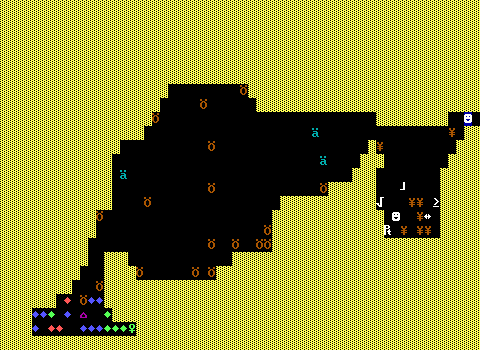
The opening few minutes to the game are handled rather well, especially for what is stated to be Funk's first release. Players don't actually start in the city, first having to find a key to the gate and fighting some built-ins in a dark room nearby. It sets the bar admittedly fairly low, but because this portion of the game is just two boards long, Funk gets to quickly surprise players with the realization that this isn't going to just be running around in dark boards shooting at lions. There's something more complex here.
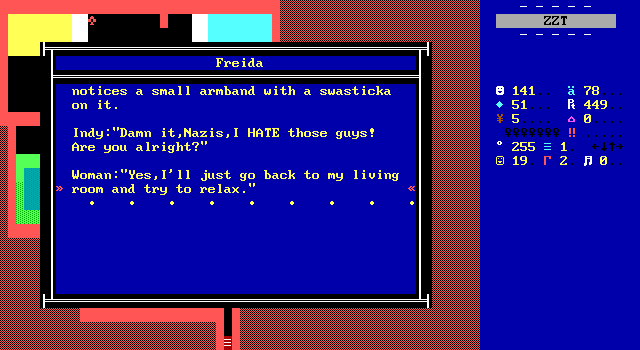
As players uncover the keys to the vault, they'll also find their share of information about the city. The elders were taken away by none other than Jones's most hated villains. Yes, despite original premise making the game seem like it's just going to be a few steps removed from Town with Indiana Jones for a hero instead of a generic ZZT adventurer, this is indeed another match-up of Indy vs. the Nazis.
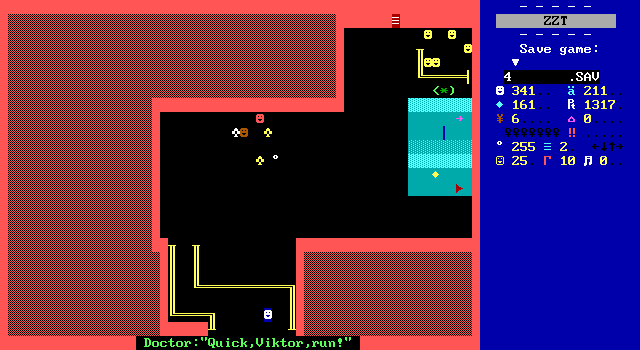
Eventually Indy finds the elders, and a way to the surface, along with some fascists discussing their grand scheme. The mystery is revealed, and is a bit silly, but perfectly fine to justify Indiana's underground adventure. A long time a go there was a war on the island, and a machine was developed which would wipe the memories of people, leaving them incredibly vulnerable to the power of suggestion. The Nazis learned of the device, and wanted nothing more than to have it for the themselves, and began kidnapping elders to find someone who knew how to operate the device. Indy sends the villains packing, saves the day, and... actually he just leaves the machine down there. I feel like it might be best kept in that big warehouse with the ark.
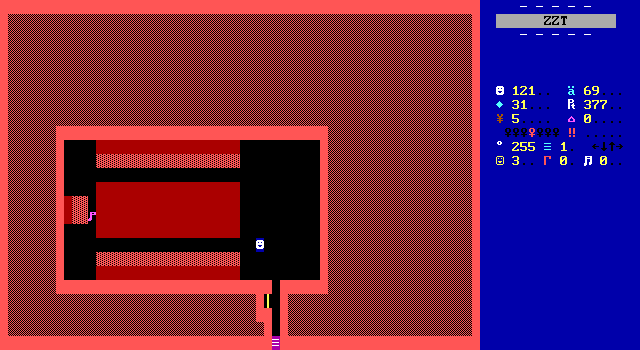
Really, the story is a quick justification to allow everything that needs to happen to happen. For the majority of the game, the player will find themselves just looking for keys, with no mention of the Nazis or the machine until a considerable portion of the game is completed. I can't be too had on it because there's so little to it, and ZZT games like this one don't need to have anything too exciting. As long as players are able to go exploring, shoot some ruffians (fascists, ...except for the one time where they're bats), and perform a few simple fetch quests, they're going to have a good time and be happy to stick around.
Although, I will admit that the people living underground being just as confused at the subterranean city as Indy is did make me curious what Funk's answer was going to be. Alas, the game is basic enough that I didn't let myself think about it too hard as this is a ZZTer's first release and from the mid 1990s. I wanted to keep my expectations reasonable.
There's also the obvious question of the game's title Lost Crusaders, which is almost but not quite The Last Crusade. Funk really seems to have given no thought as to why the game should be called that beyond it sounding like an Indiana Jones title. I suppose by not using the name of one of the films, there are no expectations for the story. Nothing in this game has anything to do with any sort of crusade. Some people are lost, in the sense that they're being held prisoner and are missing, but that's about it. Indiana Jones and the Kingdom of Zurk might have better reflected the game's actual contents. Really though, it's the first two words that are going to be responsible for 99% of interest in the game, especially back then when the title was all people got to decide if a ZZT game sounded like an interesting download. I'm just the one weirdo who went for the game because of its author.
Dr. Jones and Mr. Indiana
ZZT has had its share of such titles over the years, benefiting from how easy it is to adapt the character of Indiana Jones into numerous styles of gameplay, and created for a program that was obscure enough that Lucas's lawyers weren't likely to notice and come knocking. Depending on the exact release of Indy Jones in The Lost Forest of The Ancients, there's potential that Funk was the first person to make an Indiana Jones ZZT world. I am a bit more confident that he's the first to make one that's engaging and fun to play.
All the same, there isn't all that much that's particularly "Indy" here. Many of his more iconic features are hardly noticeable, or absent entirely. His whip, for example, doesn't come up once. Indy's certainly no stranger when it comes to firearms, but Funk was unable to work the iconic prop even into the game's text. An Indiana Jones game without a whip doesn't feel particularly Indy at all.
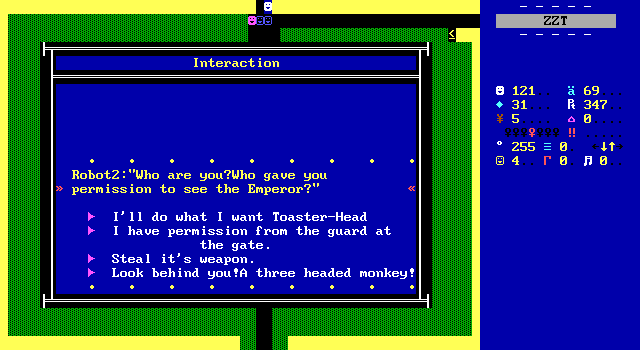
Where Funk does a better job of portraying the character is through the game's dialog. Funk's Indy is almost incapable of holding his tongue, frequently insulting anyone that gets in his way, whether that be the actual villains or just random characters making demands of him. In many instances, players get to choose how Indy responds to someone, with Funk making sure to include some line full of bravado as an option. These lines feel in-character, though more often than not, picking these options gets the player killed immediately. The reactions are definitely worth seeing so players will want to get in the habit of saving before speaking just to see what demise is in store for the man.
Seriously some of them get pretty out there. Yeah you're got your more expected bad ends of being shot, stabbed, or choked, but Funk is acutely aware that if you're going to hand out an #endgame for making a poor decision, that the least he can do is keep players entertained when it happens. One such incident involves threatening a robot that responds by self-destructing its atomic core. This creates an explosion so large that the Earth is knocked out of orbit and crashes into the sun, causing all the Earth's nukes to explode, etc. etc. tl;dr the universe is annihilated.
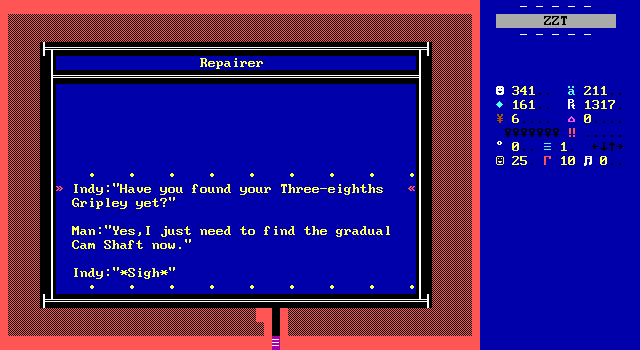
As with the Indy seen in the films, the one here does have his moral standards. He can help out, and when it comes to real injustices is willing to protect others, but he's not here to fix everyone's problems. There's a lot going on in this game that he just kind of ignores because it isn't relevant to his goal of escaping from the underground or dire enough that people are being hurt. There's a repairman working on a broken robot is unable to find a tool needed to fix them. Indy never gets to find said item, leaving the issue unresolved until it is brought up again as a joke in the ending celebration. An unfurnished home has some religious symbol drawn on the floor, with the owner complaining how he lets a group rent out the space once a week, but lately they've been locking him out. Whatever group this is never comes up, and his troubles too will also go unresolved.

Even when speaking to the ruler of the underground who asks for help, players are given the option to be surprisingly dismissive of the missing elders. Indy can say he's too busy to talk with the king, as well as choose to "think about" helping him and go about his business instead of accepting the request to find the elders. Ezanya this ain't.
Whenever a character does manage to make Indy mad, they'll quickly regret their mistake. While most enemies fought in the game are ZZT's creatures, there are a few special encounters where your foes are custom objects. These give Funk greater control over how the fights play out, which include finding a man sexually harassing a woman (in a very PG "Hehe give me a kiss" way) who Indy taps on the shoulder, before decking him right on the nose with such force that he dies. Thank you for your service Mr. Jones.
He's not exclusively a jerk at least. For an unexpected laugh, upon approaching the king of the underground city for the first time, one of the things players can choose to do is not speak, but to just start tap-dancing, very much confusing the king, but thankfully a harmless action.
Zurk: The Great Underground Empire
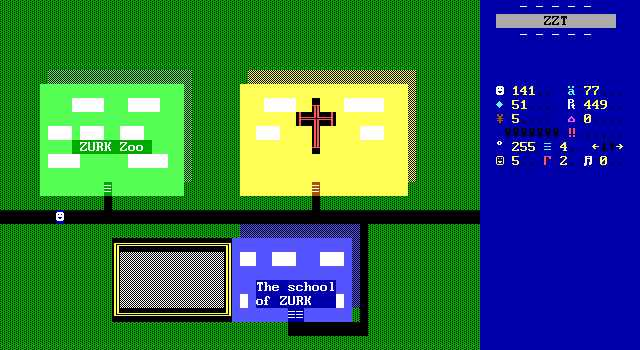
Once the player arrives in the under city of Zurk, the game is reasonably open ended. There are plenty of parallels to be made to Town in terms of structure, though like most ZZT games released in an era when even new authors likely had access to more games than Town, there's more to the game than a series of room-specific challenges. Lost Crusaders is a great example of how Town's ideals as to what a ZZT game should be still remained a recognizable influence many years later long after authors had moved on from the formula.
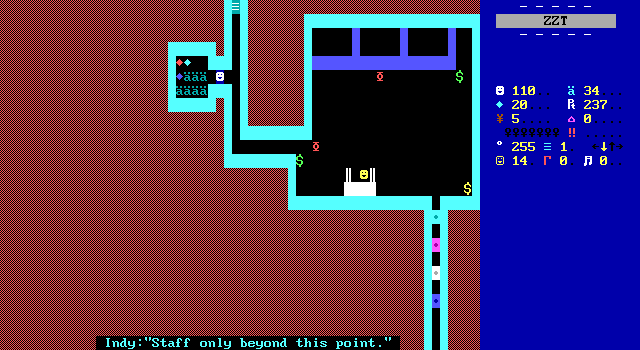
There's still the more shallow comparisons to be made here, with a little bit of reshuffling. In Funk's city, players are free to enter the palace, instead focused on finding four unique keys that open the vault of the bank rather than a combination lock. At its heart, Indy's journey is still a purple key game, just a little obfuscated by Funk's additional story and more realistic portrayal of a city or small town. Well, "Realistic" in the sense that when you enter the bank, you'll find windows for tellers, rather than an obstacle course to test your reflexes.
Unlike the original ZZT saga, puzzles are removed entirely, with action favored instead. It's considerably easier for authors, especially ones both new and young, to come up with a pleasing arrangement of ruffians for players to engage with than it is to try to come design a slider-based or original puzzle design. Speaking from personal biases, when I was a young child playing ZZT, I was not a fan of puzzles at all as all too often they stopped me in my tracks entirely. If I'm not alone here, then perhaps Funk also opted to avoid including the kind of material he struggled to get past just as I used to.
Since this game is a good five years older than Town, Funk has much wider options available to look at for guidance. The fact that the game makes some use of Super Tool Kit's extended colors is proof enough that Funk wasn't creating worlds in a vacuum. A few early ZZT worlds snuck on to certain shareware CDs and the like, but odds are anybody aware of STK had some source for a variety of ZZT worlds and opportunity to find more elsewhere.
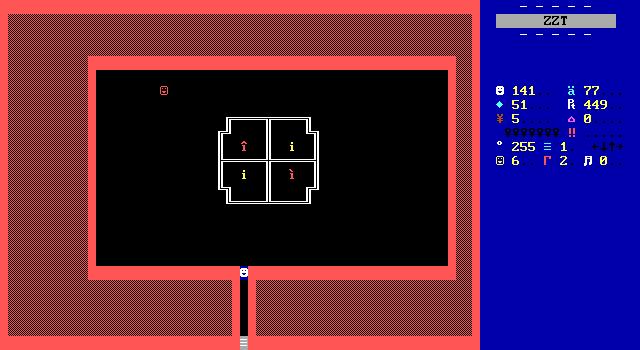
Most of Zurk (which honestly I have no idea if it's meant to be a play on Zork as I did for the heading or not) is generic enough that confidently citing specific games is a fool's errand. Some candles are animated using the exact animation seen in Code Red. A zoo gives players an overview of creatures a bit like Aceland's museum. Going beyond that get sketchy. There's a church and Aceland has one of those, but so do dozens of other worlds. Maybe this poor child was playing Dan Shootwrong. A TV station is found on the outskirts of the city. Perhaps this is also replicating what was seen in Code Red? It's impossible to say, and hardly unthinkable that somebody thought of including such places in their game independently.
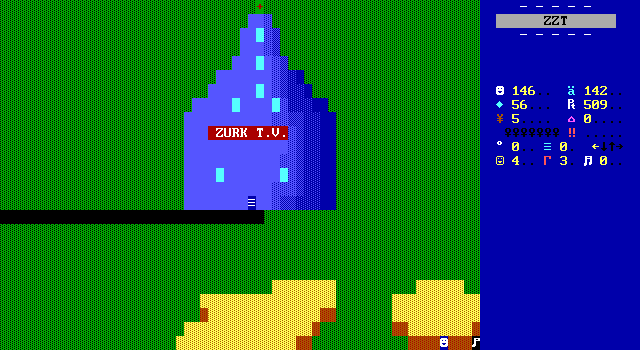
For Indy and the player controlling him though, the city is a laid-back environment, at least on the outside. Most boards consist of dark green grass that I was expecting to actually be forest tiles. A small garden uses gems to let Indy pilfer and profit from a snack. Some wheat fields lie on the edge of town, where the lack of any border implies that there is more to Zurk than players see for themselves. Props to Funk here for this specifically. The change from homes and businesses to farmland is a nice signifier that there's nothing else beyond this point, without having to include a physical barrier to block players from trying to keep exploring.

For homes, a large apartment complex groups two unlocked-doors in close proximity where Indy can save a woman from attackers in one and learn a bit of strange rituals being performed in another. To help the city feel large without actually needing to pad the game out with unessential locations, several fake passages to apartments are also included, revealing themselves to be locked doors, or a condemned unit.
Funk rather nicely keeps things fairly compact. Zurk's non-interior boards are split across five boards, with most containing several locations for Indy to check out the interior of. It's very quick and easy to explore, which works out quite nicely given that there isn't really a lot lot to do in most locations. It never gets tiring, and even the one time I was unsure of where to go next, it was easy to avoid frustration by being able to cover so much of the city with so little delay between each location.
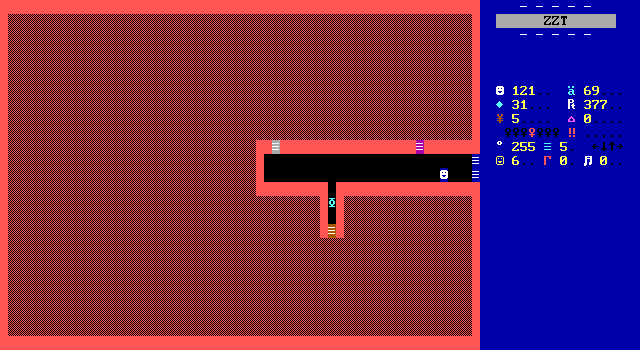
The palace is a more unique case. It comes with a number of rooms Indy can explore that rivals the rest of Zurk, all in one building. It ends up feeling more like a hotel, as most of the rooms that can be entered are guest bedrooms, barring a few others related to food prep and dining. One of the rooms is even given to Indy once he accepts the king's quest to find the missing elders.
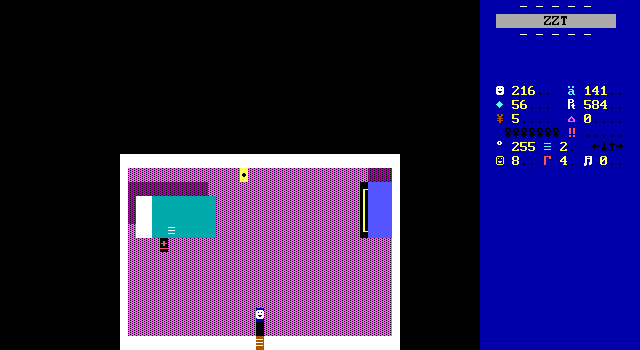
Indy's room ends up leading to one of the more surreal segments. The bedroom is straightforward enough with a bed, TV set, and a drawer where the former occupants forgot to pack up some of their gems and torches. This drawer means the bedroom performs the most-expected function of a private room in a ZZT world, healing the player, and in a way that's different that the usual method of going to sleep.
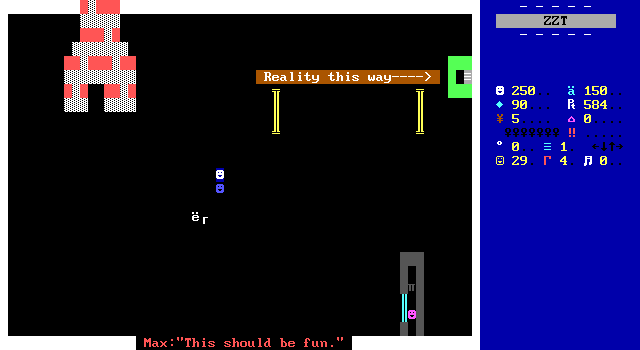
Where it gets surreal is that players can still go to sleep. This brings players into Indy's dream which is Funk's opportunity to include some staples of mid-90s ZZT as well as his personal favorite characters without having to worry about the fact that this game is an Indiana Jones game. If you thought this game wouldn't have Barney the dinosaur in it, you thought wrong.
The purple dinosaur isn't victimized by Indy however. He meets his demise at the hands of none other than Sam and Max, freelance police. As far as cameos go, the duo are actually pretty fitting for an Indiana Jones game given their own adventure game also being a LucasArts production. Funk's inclusion of them comes off more like a fan sharing them with the world rather than specifically considering the potential brand synergy here. The entire scene to me felt more like meeting a bunch of pro wrestlers in Keesh's Quest 2 with the LucasArts connection being more of a coincidence. I suspect Funk would have worked Sam and Max (and Barney) into whatever he was making at the time.

